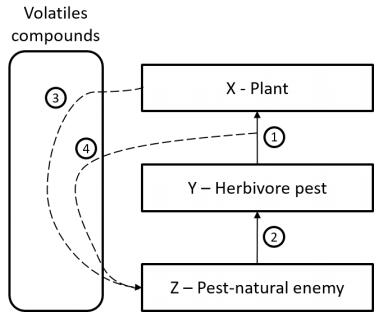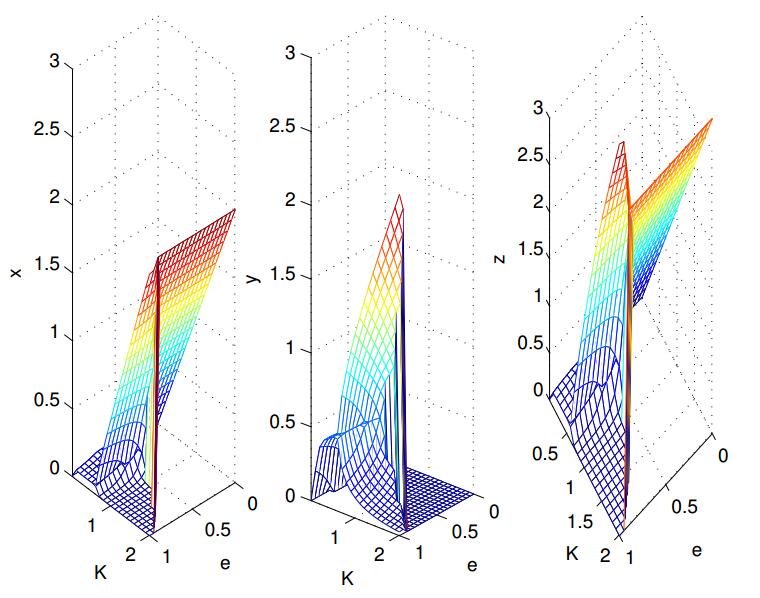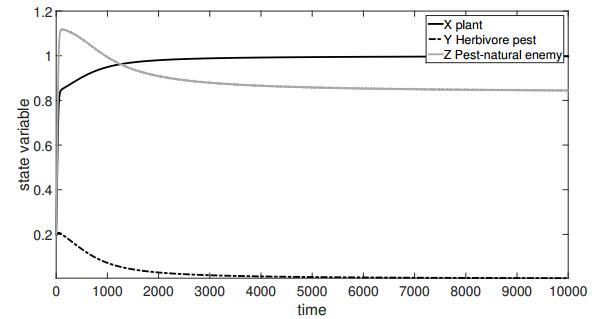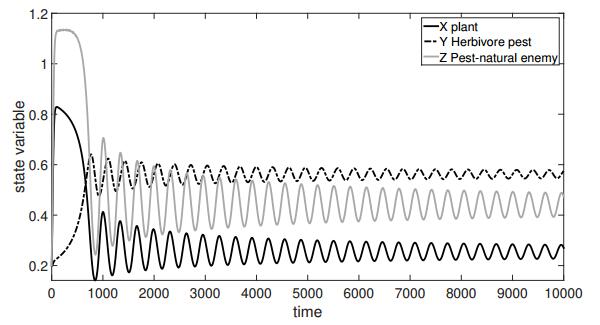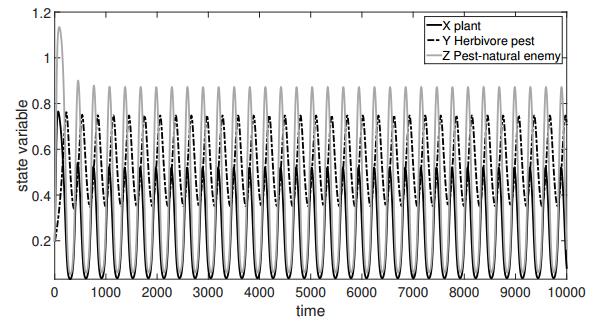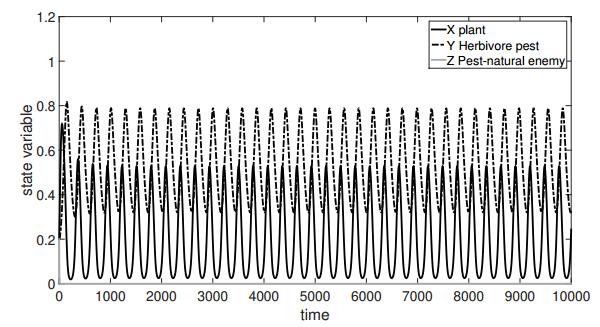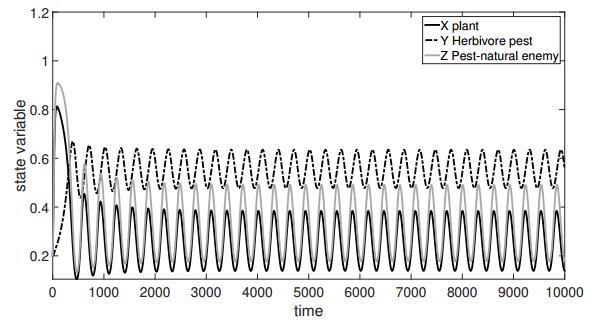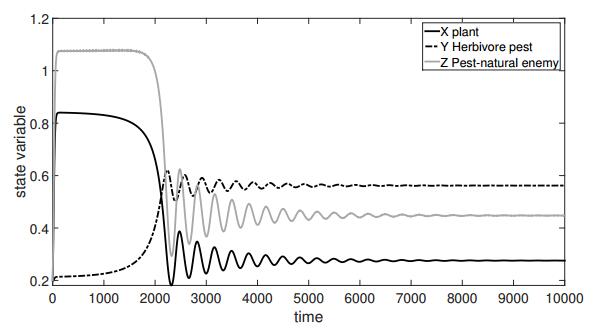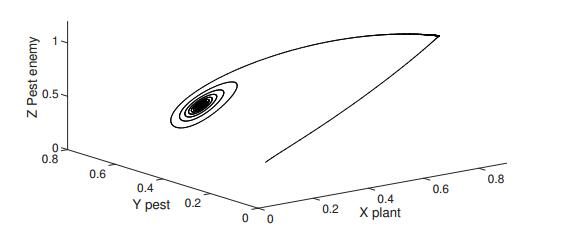We introduce a mathematical model to describe the tritrophic interaction between crop, pest and the pest natural enemy where the release of Volatile Organic Compounds (VOCs) by crop is taken into account. The VOCs may be considered as an indirect defence mechanism of the plant as they attract the pest natural enemies toward the attacked plants. The model dynamics is studied through qualitative analysis and numerical simulations. The factors that may enhance pest disappearance are identified. In particular, we show that VOCs may have a beneficial effect on the environment since their release may be able to stabilize the model dynamics. Specifically, for the parameter values that we have explored, this effect can arise only when both the phenomena of VOCs basic plant release and VOCs plant release due to pest attack are present.
1.
Introduction
Difference equations are the essentials required to understand even the simplest epidemiological model: the SIR-susceptible, infected, recovered-model. This model is a compartmental model, which results in the basic difference equation used to measure the actual reproduction number. It is this basic model that helps us determine whether a pathogen is going to die out or whether we end up having an epidemic. This is also the basis for more complex models, including the SVIR, which requires a vaccinated state, which helps us to estimate the probability of herd immunity.
There has been some recent interest in studying the qualitative analysis of difference equations and system of difference equations. Since the beginning of nineties there has be considerable interest in studying systems of difference equations composed by two or three rational difference equations (see, e.g., [4,5,6,2,8,9,11,10,14,15,17,19,20] and the references therein). However, given the multiplicity of factors involved in any epidemic, it will be important to study systems of difference equations composed by many rational difference equations, which is what we will do in this paper.
In [2], Devault et al. studied the boundedness, global stability and periodic character of solutions of the difference equation
where m∈{2,3,…}, p is positive and the initial conditions are positive numbers.
In [20], Zhang et al. investigated the behavior of the following symmetrical system of difference equations
where the parameter A is positive, the initial conditions xi,yi are arbitrary positive numbers for i=−m,−m+1,…,0 and m∈N. While this study is good, we note that the authors did not investigate various device properties, such as the stability nature, the rate of convergence and the asymptotic behavior.
Complement of the work above, in [8], Gümüş studied the global asymptotic stability of positive equilibrium, the rate of convergence of positive solutions and he presented some results about the general behavior of solutions of system (2). Our aim in this paper is to generalize the results concerning equation (1) and system (2) to the system of p nonlinear difference equations
where A is a nonnegative constant and x(j)−m,x(j)−m+1,…,x(j)−1,x(j)0,j=1,2,…,p are positive real numbers.
The remainder of the paper is organized as follows. In Section (2), we introduce some definitions and notations that will be needed in the sequel. Moreover, we present, in Theorem (2.4), a result concerning the linearized stability that will be useful in the main part of the paper. Section (3) discuses the behavior of positive solutions of system (3) via semi-cycle analysis method. Furthermore, Section (4) is devoted to study the local stability of the equilibrium points and the asymptotic behavior of the solutions when 0≤A<1,A=1 and A>1. In Section (5), we turn our attention to estimate the rate of convergence of a solution that converges to the equilibrium point of the system (3) in the region of parameters described by A>1. Some numerical examples are carried out to support the analysis results in Section (6). Section (7) summarizes the results of this work, draws conclusions and give some interesting open problems for difference equations theory researchers.
2.
Preliminaries
In this section we recall some definitions and results that will be useful in our investigation, for more details see [3,7,14,13].
Definition 2.1. (see, [14]) A 'string' of sequential terms {x(j)μ,…,x(j)ν}, μ≥−1, ν≤+∞ is said to be a positive semi-cycle if x(j)i≥¯x(j), i∈{μ,…,ν}, x(j)μ−1<¯x(j) and x(j)ν+1<¯x(j), j∈{1,2,…,p}.
A 'string' of sequential terms {x(j)μ,…,x(j)ν}, μ≥−1, ν≤+∞ is said to be a negative semi-cycle if x(j)i<¯x(j), i∈{μ,…,ν}, x(j)μ−1≥¯x(j) and x(j)ν+1≥¯x(j), j∈{1,2,…,p}.
A 'string' of sequential terms {(x(1)μ,x(2)μ,…,x(p)μ),…,(x(1)ν,x(2)ν,…,x(p)ν)}, μ≥−1, ν≤+∞ is said to be a positive semi-cycle (resp. negative semi-cycle) if if {x(1)μ,…,x(1)ν},…,{x(p)μ,…,x(p)ν} are positive semi-cycles (resp. negative semi-cycles).
A 'string' of sequential terms {(x(1)μ,x(2)μ,…,x(p)μ),…,(x(1)ν,x(2)ν,…,x(p)ν)}, μ≥−1, ν≤+∞ is said to be a positive semi-cycle (resp. negative semi-cycle) with respect to x(q)n and negative semi-cycle (resp. positive semi-cycle) with respect to x(s)n if {x(q)μ,…,x(q)ν} is a positive semi-cycle (resp. negative semi-cycle) and {x(s)μ,…,x(s)ν} is a negative semi-cycle (resp. positive semi-cycle).
Definition 2.2. (see, [14]) A function x(i)n oscillates about ¯x(i) if for every ξ∈N there exist μ,ν∈N, μ≥ξ, ν≥ξ such that
We say that a solution {x(1)n,x(2)n,…,x(p)n}n≥−m of system (3) oscillates about (¯x(1),¯x(2),…,¯x(p)) if x(q)n oscillates about ¯x(q), q∈{1,2,…,p}.
Let f(1),f(2),…,f(p) be p continuously differentiable functions:
where Ii,i=1,2,…,p are some intervals of real numbers. Consider the system of difference equations
where n,k∈N0, (x(i)−k,x(i)−k+1,…,x(i)0)∈Ik+1i,i=1,2,…,p.
Define the map
by
where
Let
Then, we can easily see that system (4) is equivalent to the following system written in vector form
Definition 2.3. (see, [13]) Let (¯x(1),¯x(2),…,¯x(p)) be an equilibrium point of the map F where f(i), i=1,2,…,p are continuously differentiable functions at (¯x(1),¯x(2),…,¯x(p)). The linearized system of (3) about the equilibrium point (¯x(1),¯x(2),…,¯x(p)) is
where Xn=(x(1)n,x(1)n−1,…,x(1)n−k,x(2)n,x(2)n−1,…,x(2)n−k,…,x(p)n,x(p)n−1,…,x(p)n−k)T and B is a Jacobian matrix of the system (3) about the equilibrium point (¯x(1),¯x(2),…,¯x(p)).
Theorem 2.4. (see, [13])
1. If all the eigenvalues of the Jacobian matrix B lie in the open unit disk |λ|<1, then the equilibrium point ¯X of system (3) is asymptotically stable.
2. If at least one eigenvalue of the Jacobian matrix B has absolute value greater than one, then the equilibrium point ¯X of system (3) is unstable.
3.
Semi-cycle analysis
In this section, we discuss the behavior of positive solutions of system (3) via semi-cycle analysis method. It is easy to see that system (3) has a unique positive equilibrium point (¯x(1),¯x(2),…,¯x(p))=(A+1,A+1,…,A+1).
Lemma 3.1. Let {(x(1)n,x(2)n,…,x(p)n)}n≥−m be a solution to system (3). Then, either {(x(1)n,x(2)n,…,x(p)n)}n≥−m consists of a single semi-cycle or {(x(1)n,x(2)n,…,x(p)n)}n≥−m oscillates about the equilibrium (¯x(1),¯x(2),…,¯x(p))=(A+1,A+1,…,A+1) with semi-cycles having at most m terms.
Proof. Suppose that {(x(1)n,x(2)n,…,x(p)n)}n≥−m has at least two semi-cycles. Then, there exists n0≥−m such that either
We suppose the first case, that is, x(j)n0<A+1≤x(j)n0+1. The other case is similar and will be omitted. Assume that the positive semi-cycle beginning with the term (x(1)n0+1,x(2)n0+1,…,x(p)n0+1) have m terms. In this case we have
So, we get from system (3)
The Lemma is proved.
Lemma 3.2. Let {(x(1)n,x(2)n,…,x(p)n)}n≥−m be a solution to system (3) which has m−1 sequential semi-cycles of length one. Then, every semi-cycle after this point is of length one.
Proof. Assume that there exists n0≥−m such that either
or
We will prove the case (6). The case (7) Is identical and will not be included. According to system (3) we obtain
and
The result proceeds by induction. Thus, the proof is completed.
Lemma 3.3. System (3) has no nontrivial periodic solutions of (not necessarily prime) period m.
Proof. Suppose that
is a m-periodic solution of system (3). It is obvious then that for this solution,
So, the equilibrium solution (¯x(1),¯x(2),…,¯x(p))=(A+1,A+1,…,A+1) must be this solution. Thus, the proof is completed.
Lemma 3.4. All non-oscillatory solutions of system (3) converge to the equilibrium (¯x(1),¯x(2),…,¯x(p))=(A+1,A+1,…,A+1).
Proof. We assume there exists non-oscillatory solutions of system (3). We will prove this lemma for the case of a single positive semi-cycle, the situation is identical for a single negative semi-cycle, so it will be omitted. Assume that (x(1)n,x(2)n,…,x(p)n)≥(¯x(1),¯x(2),…,¯x(p)) for all n≥−m. From system (3) we have
So, we get
From (8), there exists δ(j)i fori=0,1,…,m−1 such that
Hence,
is a periodic solution of (not necessarily prime period) period m. But, from Lemma (3.3), we saw system (3) has no nontrivial periodic solutions of (not necessarily prime period) period m. Thus, the solution must be the equilibrium solution. So, the proof is over.
4.
The asymptotic behavior
4.1. The Case 0<A<1
Theorem 4.1. Suppose 0<A<1 and {(x(1)n,x(2)n,…,x(p)n)}n≥−m be a positive solution to system (3). Then the following statements hold.
ⅰ): If m is odd, and 0<x(j)2k−1<1, x(j)2k>11−A for k=1−m2,3−m2,…,0, then
ⅱ): If m is odd, and 0<x(j)2k<1, x(j)2k−1>11−A for k=1−m2,3−m2,…,0, then
Proof. (ⅰ): From (3), for i=1,2,…,p, we get
By induction, for n =0,1,2,… and i=1,2,…,p, we obtain
So, from (3) and (9), we have
So
By limiting the inequality (10), we get
On the other hand, from(3), (9) and (11), we get
(ⅱ): The proof is similar to the proof of (ⅰ).
Open Problem. Investigate the asymptotic behavior of the system (3) when m is even.
4.2. The Case A=1
Lemma 4.2. Suppose A=1. Then every positive solution of the system (3) is bounded and persists.
Proof. Let {(x(1)n,x(2)n,…,x(p)n)}n≥−m be a positive solution to system (3). Then, it is clear that for n≥1, x(j)n>A=1,j=1,2,…,p. So, we get
where
So, we get
thus, the following is obtained
By induction, we get
Theorem 4.3. Suppose A=1 and {(x(1)n,x(2)n,…,x(p)n)}n≥−m be a positive solution to system (3). Then
Proof. From (12), we can set
We first prove the theorem for p=2. From system (3), we have
which implies
thus, the following equalities are obtained
So, we get that m1=m2 and L1=L2. Now we suppose that
From system (3), we have
hence, we get
consequently, the following equalities are obtained
So, we get that mp=mp−1 and Lp=Lp−1. Thus, the proof completes.
4.3. The Case A>1
Theorem 4.4. Assume that A>1. Then, the unique positive equilibrium (¯x(1),¯x(2),…,¯x(p))=(A+1,A+1,…,A+1) of system (3) is locally asymptotically stable.
Proof. The linearized equation of system (3) about the equilibrium point (¯x(1),¯x(2),…,¯x(p)) is
where Xn=(x(1)n,x(1)n−1,…,x(1)n−m,x(2)n,x(2)n−1,…,x(2)n−m,…,x(p)n,x(p)n−1,,…,x(p)n−m)t, and B=(bij), 1≤i,j≤pm+p is an (pm+p)×(pm+p) matrix such that
where A,J and O are (m+1)×(m+1) matrix defined as follows
Let λ1,λ2,…,λpm+p denote the eigenvalues of matrix B and let
be a diagonal matrix where d1=dm+2=d2m+3=⋯=d(p−1)m+p=1, dk=dm+1+k=1−kε for k∈{1,2,…,p2(m+1)}. Since A>1, we can take a positive number ε such that
It is obvious that D is an invertible matrix. Computing matrix DBD−1, we get
where
and
From d1>d2>…>dp2(m+1) and dp2(m+1)+1>dp2(m+1)+2>…>dpm+p we can get that
Moreover, from A>1 and (16) we have
It is common knowledge that B has the same eigenvalues as DBD−1, we have that
We have that all eigenvalues of B lie inside the unit disk. According to Theorem (2.4) we obtain that the unique positive equilibrium (¯x(1),¯x(2),…,¯x(p))=(A+1,A+1,…,A+1) is locally asymptotically stable. Thus, the proof is completed.
To prove the global stability of the positive equilibrium, we need the following lemma.
Lemma 4.5. Suppose A>1. Then every positive solution of the system (3) is bounded and persists.
Proof. Let {(x(1)n,x(2)n,…,x(p)n)}n≥−m be a positive solution to system (3). Then, it is clear that for n≥1, x(j)n>A>1,j=1,2,…,p. So, we get
where
So, we get
thus, the following is obtained
By induction, we get
Theorem 4.6. Assume that A>1. Then the positive equilibrium of system (3) is globally asymptotically stable.
Proof. Let {(x(1)n,x(2)n,…,x(p)n)}n≥−m be a solution of system (3). By Theorem (4.4) we need only to prove that the equilibrium point (A+1,A+1,…,A+1) is global attractor, that is
To do this, we prove that for i=1,2,…,p, we have
From Lemma (4.5), we can set
So, from (3) and (13), we have
We first prove the theorem for p=2. From (19), we get
So,
hence
since A>1, It follows that
we know that L1−m1≥0 and L2−m2≥0, so we obtain L1=m1 and L2=m2. Now we assume that the theorem holds for p−1, that is Li=mi,i=1,2,…,p−1 and prove the theorem for p. From (19), we have
So,
Thus, the following inequality is obtained
since A>1, L1−m1≥0 and Lp−mp≥0, we obtain Lp=mp, it signify that
Therefore every positive solution {(x(1)n,x(2)n,…,x(p)n)}n≥−1 of system (3) tends to (A+1,A+1,…,A+1) as n→+∞.
5.
Rate of convergence
In this section, we estimate the rate of convergence of a solution that converges to the equilibrium point (¯x(1),¯x(2),…,¯x(p))=(A+1,A+1,…,A+1) of the system (3) in the region of parameters described by A>1. We give precise results about the rate of convergence of the solutions that converge to the equilibrium point by using Perron's theorems. The following result gives the rate of convergence of solutions of a system of difference equations
where Xn is a (pm+p)-dimensional vector, A∈C(pm+p)×(pm+p) is a constant matrix and B:Z+→C(pm+p)×(pm+p) is a matrix function satisfying
where ‖.‖ indicates any matrix norm which is associated with the vector norm ‖.‖.
Theorem 5.1. (Perron's first Theorem, see [16]) Suppose that condition (21) holds. If Xn is a solution of (20), then either Xn=0 for all largen or
exists and is equal to the modulus of one of the eigenvalues of matrix A.
Theorem 5.2. (Perron's second Theorem, see [16]) Suppose that condition (21) holds. If Xn is a solution of (20), then either Xn=0 for all largen or
exists and is equal to the modulus of one of the eigenvalues of matrix A.
Theorem 5.3. Assume that a solution {(x(1)n,x(2)n,…,x(p)n)}n≥−m of system (3) converges to the equilibrium (¯x(1),¯x(2),…,¯x(p)) which is globally asymptotically stable. Then, the error vector
of every solution of system (3) satisfies both of the following asymptotic relations:
where |λiJF((¯x(1),¯x(2),…,¯x(p)))| is equal to the modulus of one the eigenvalues of the Jacobian matrix evaluated at the equilibrium point (¯x(1),¯x(2),…,¯x(p)).
Proof. First, we will find a system that satisfies the error terms. The error terms are given as
for i=1,2,…,m,j=1,2,…,p. Set
Then, system (22) can be written as
where
and the others parameters (k)A(j)i are equal zero.
If we consider the limiting case, It is obvious then that
That is
where α(i)n,β(i)n→0 when n→∞. Now we have the following system of the form (20)
where en=(e(1)n,e(1)n−1,…,e(1)n−m,e(2)n,e(2)n−1,…,e(2)n−m,…,e(p)n,e(p)n−1,…,e(p)n−m)t and
where
and A,J and O are the (m+1)×(m+1) matrix defined in (14) and (15).
‖Bn‖→0 when n→∞. Therefore, the limiting system of error terms can be written as
and ‖Bn‖→0 when n→∞. This system is exactly the linearized system of (3) evaluated at the equilibrium point (¯x(1),¯x(2),…,¯x(p)). From Theorems (5.1) and (5.2), the result follows.
6.
Numerical examples
In this section we will consider several interesting numerical examples to verify our theoretical results. These examples shows different types of qualitative behavior of solutions of the system (3). All plots in this section are drawn with Matlab.
Exemple 6.1. Let m=1 and p=10 in system (3), then we obtain the system
with A=1.2>1 and the initial values x(1)−1=3.3,x(1)0=2,x(2)−1=1.1,x(2)0=0.3,x(3)−1=2.3,x(3)0=1.5,x(4)−1=0.5,x(4)0=2,x(5)−1=1.9,x(5)0=0.8,x(6)−1=4,x(6)0=1.3,x(7)−1=1.2,x(7)0=1.3,x(8)−1=2.1,x(8)0=2.3,x(9)−1=3.6,x(9)0=0.2,x(10)−1=2.3,x(10)0=1.1. Then the positive equilibrium point (¯x(1),¯x(2),…,¯x(10))= (2.2,2.2,…,2.2) of system (23)) is globally asymptotically stable (see Figure (1), Theorem (4.4)).
Exemple 6.2. Consider the system (23) with A=1 and the initial values x(1)−1=0.3,x(1)0=1.1,x(2)−1=1.3,x(2)0=0.3,x(3)−1=1.4,x(3)0=1.5,x(4)−1=0.5,x(4)0=2,x(5)−1=1.9,x(5)0=0.8,x(6)−1=4,x(6)0=1.3,x(7)−1=1.4,x(7)0=1.3,x(8)−1=0.1,x(8)0=1.1,x(9)−1=1.6,x(9)0=1.7,x(10)−1=1.9,x(10)0=1.1. Then the solution oscillates about the positive equilibrium point (¯x(1),¯x(2),…,¯x(10))=(2,2,…,2) of system (23) with semi-cycles having at most five terms. Also, the equilibrium is not globally asymptotically stable (see Figure (2), Theorem 4.2).
Exemple 6.3. Consider the system (23) with A=0.9 and the initial values x(1)−1=1.2,x(1)0=0.7,x(2)−1=1.2,x(2)0=2.3,x(3)−1=0.4,x(3)0=1.1,x(4)−1=0.8,x(4)0=8,x(5)−1=1.3,x(5)0=1.8,x(6)−1=2.6,x(6)0=0.9,x(7)−1=1.4,x(7)0=1.1,x(8)−1=0.1,x(8)0=1.4,x(9)−1=0.9,x(9)0=1.3,x(10)−1=1.2,x(10)0=2.1. Then the positive equilibrium point (¯x(1),¯x(2),¯x(3),¯x(4))=(1.9,1.9,…,1.9) of system (23) is not globally asymptotically stable. Also, this solution is unbounded solution see Figure (3), Theorem 4.2).
Exemple 6.4. Let m=5 and p=4 in system (3), then we obtain the system
with A=1.4>1 and the initial values x(1)−5=1.2,x(1)−4=0.8,x(1)−3=1.9,x(1)−2=2.2,x(1)−1=0.3,x(1)0=1.7,x(2)−5=1.3,x(2)−4=2.4,x(2)−3=1.2,x(2)−2=0.5,x(2)−1=1.6,x(2)0=2.3,x(3)−5=0.4,x(3)−4=1.1,x(3)−3=1.4,x(3)−2=2.1,x(3)−1=0.3,x(3)0=1.1,x(4)−5=0.8,x(4)−4=1.2,x(4)−3=1.8,x(4)−2=3.1,x(4)−1=0.7,x(4)0=1.8,. Then the positive equilibrium point (¯x(1),¯x(2),¯x(3),¯x(4))=(2.4,2.4,2.4,2.4) of system (24)) is globally asymptotically stable (see Figure (4), Theorem (4.4)).
Exemple 6.5. Consider the system (24) with A=1 and the initial values x(1)−5=0.4,x(1)−4=1.3,x(1)−3=2.9,x(1)−2=1.2,x(1)−1=0.8,x(1)0=1.2,x(2)−5=0.3,x(2)−4=1.4,x(2)−3=1.3x(2)−2=0.5,x(2)−1=1.6,x(2)0=2.1,x(3)−5=1.3,x(3)−4=2.1,x(3)−3=1.4,x(3)−2=2.1,x(3)−1=0.3,x(3)0=1.5,x(4)−5=0.6,x(4)−4=1.2,x(4)−3=1.3,x(4)−2=0.8,x(4)−1=1.7,x(4)0=0.1,. Then the solution oscillates about the positive equilibrium point (¯x(1),¯x(2),¯x(3),¯x(4))=(2.4,2.4,2.4,2.4) of system (24) with semi-cycles having at most five terms. Also, the equilibrium is not globally asymptotically stable (see Figure (5), Theorem 4.2).
Exemple 6.6. Consider the system (24) with A=0.7 and the initial values x(1)−5=1.3,x(1)−4=0.9,x(1)−3=2.1,x(1)−2=0.9,x(1)−1=0.7,x(1)0=2.2,x(2)−5=1.3,x(2)−4=0.4,x(2)−3=1.3x(2)−2=1.5,x(2)−1=1.2,x(2)0=1.1,x(3)−5=1.7,x(3)−4=1.6,x(3)−3=1.5,x(3)−2=2.3,x(3)−1=0.9,x(3)0=1.5,x(4)−5=0.6,x(4)−4=1.4,x(4)−3=2.3,x(4)−2=3.1,x(4)−1=2.7,x(4)0=1.9. Then the positive equilibrium point (¯x(1),¯x(2),¯x(3),¯x(4))=(1.7,1.7,1.7,1.7) of system (23) is not globally asymptotically stable. Also, this solution is unbounded solution see Figure (6), Theorem 4.2).
7.
Conclusions and some open problems
In the paper, we studied the global behavior of solutions of system (3) composed by p rational difference equations. More exactly, we here study the global asymptotic stability of equilibrium, the rate of convergence of positive solutions. Also, we present some results about the general behavior of solutions of system (3) and some numerical examples are carried out to support the analysis results. Our system generalized the equations and systems studied in [2,8] and [20].
The findings suggest that this approach could also be useful for extended to a system with arbitrary constant different parameters, or to a system with a nonautonomous parameter, or to a system with different parameters and arbitrary powers. So, we will give the following some important open problems for difference equations theory researchers.
Open Problem 1. study the dynamical behaviors of the system of difference equations
where Ai, i=1,2,…,p are nonnegative constants and x(j)−m,x(j)−m+1,…,x(j)−1,x(j)0,j=1,2,…,p are positive real numbers.
Open Problem 2. study the dynamical behaviors of the system of difference equations
where αn is a sequence (this sequence can be chosen as convergent, periodic or bounded), and x(j)−m,x(j)−m+1,…,x(j)−1,x(j)0,j=1,2,…,p are positive real numbers.
Open Problem 3. study the dynamical behaviors of the system of difference equations
wheren,m,p∈N0, Ai, i=1,2,…,p are nonnegative constants, the parameters pi,qi, i=1,2,…,p are non-negative and x(j)−m,x(j)−m+1,…,x(j)−1,x(j)0,j=1,2,…,p are positive real numbers.
Acknowledgment(s)
This work was supported by Directorate General for Scientific Research and Technological Development (DGRSDT), Algeria.
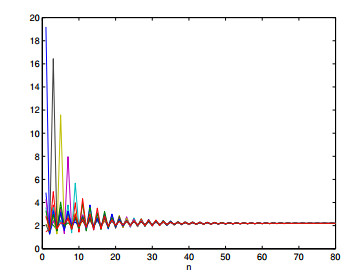









 DownLoad:
DownLoad:






